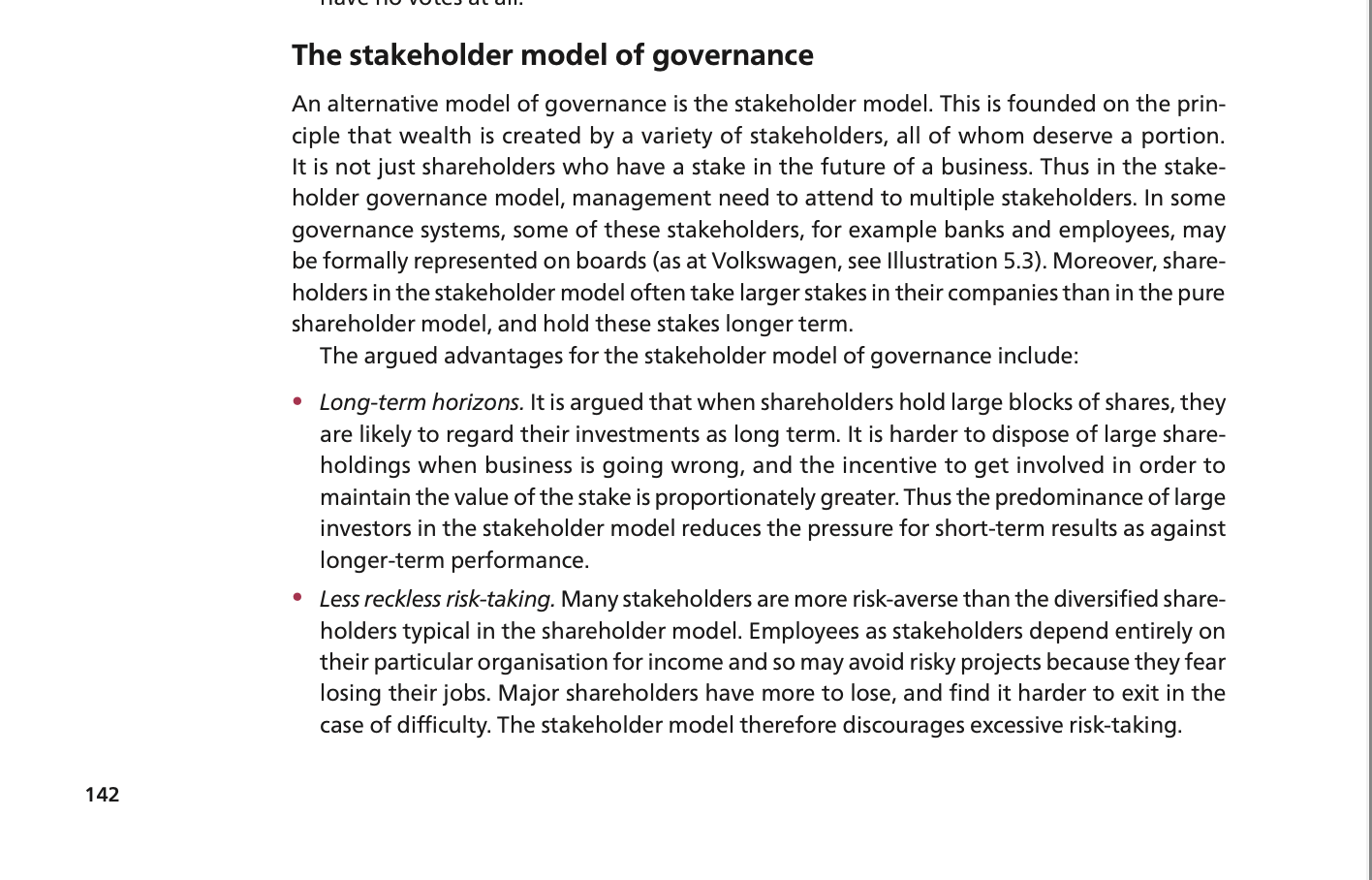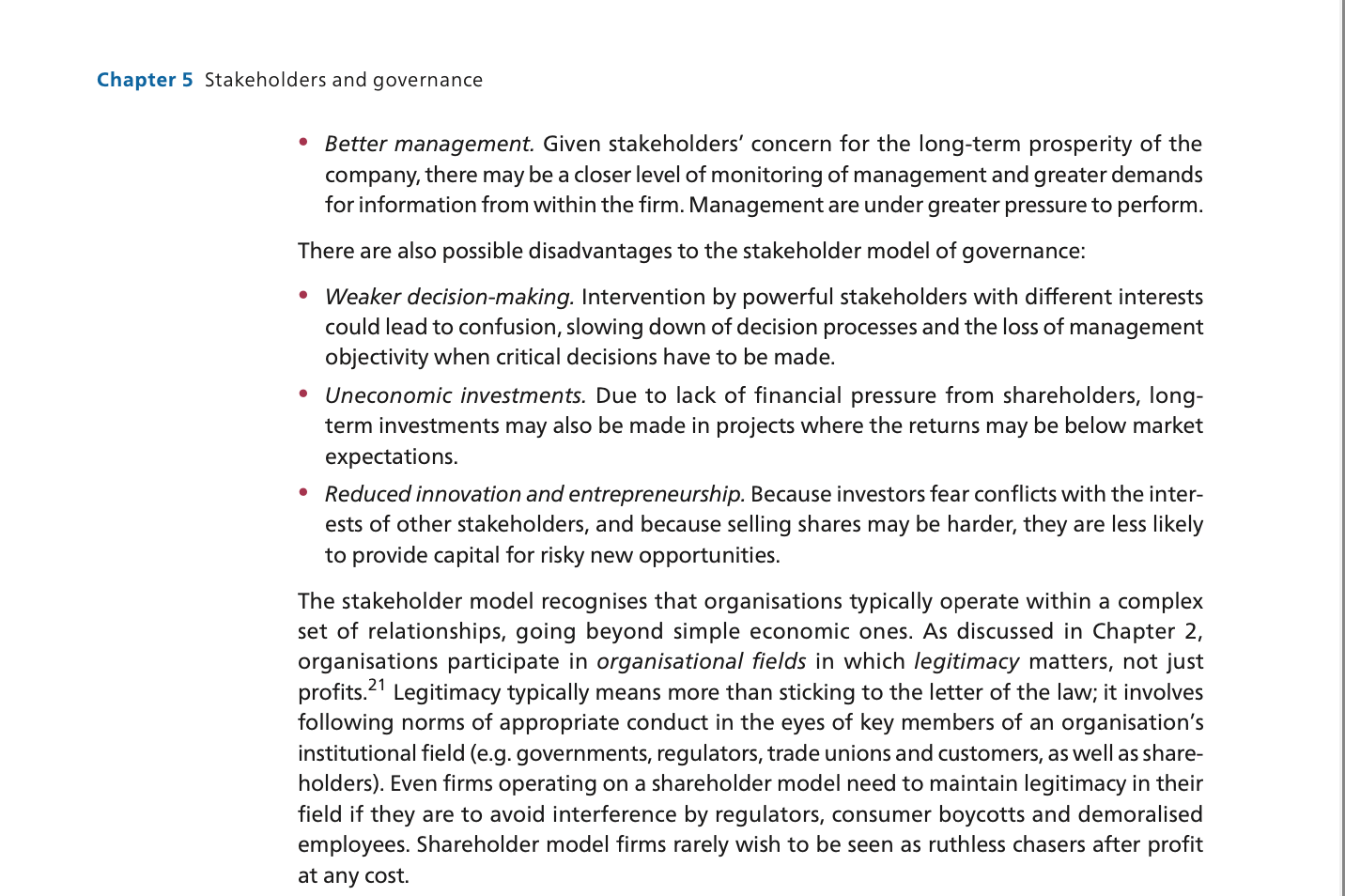Home /
Expert Answers /
Operations Management /
the-stakeholder-model-of-governance-an-alternative-model-of-governance-is-the-stakeholder-model-t-pa922
(Solved): The stakeholder model of governance An alternative model of governance is the stakeholder model. T ...
The stakeholder model of governance An alternative model of governance is the stakeholder model. This is founded on the principle that wealth is created by a variety of stakeholders, all of whom deserve a portion. It is not just shareholders who have a stake in the future of a business. Thus in the stakeholder governance model, management need to attend to multiple stakeholders. In some governance systems, some of these stakeholders, for example banks and employees, may be formally represented on boards (as at Volkswagen, see Illustration 5.3). Moreover, shareholders in the stakeholder model often take larger stakes in their companies than in the pure shareholder model, and hold these stakes longer term. The argued advantages for the stakeholder model of governance include: - Long-term horizons. It is argued that when shareholders hold large blocks of shares, they are likely to regard their investments as long term. It is harder to dispose of large shareholdings when business is going wrong, and the incentive to get involved in order to maintain the value of the stake is proportionately greater. Thus the predominance of large investors in the stakeholder model reduces the pressure for short-term results as against longer-term performance. - Less reckless risk-taking. Many stakeholders are more risk-averse than the diversified shareholders typical in the shareholder model. Employees as stakeholders depend entirely on their particular organisation for income and so may avoid risky projects because they fear losing their jobs. Major shareholders have more to lose, and find it harder to exit in the case of difficulty. The stakeholder model therefore discourages excessive risk-taking.
- Better management. Given stakeholders' concern for the long-term prosperity of the company, there may be a closer level of monitoring of management and greater demands for information from within the firm. Management are under greater pressure to perform. There are also possible disadvantages to the stakeholder model of governance: - Weaker decision-making. Intervention by powerful stakeholders with different interests could lead to confusion, slowing down of decision processes and the loss of management objectivity when critical decisions have to be made. - Uneconomic investments. Due to lack of financial pressure from shareholders, longterm investments may also be made in projects where the returns may be below market expectations. - Reduced innovation and entrepreneurship. Because investors fear conflicts with the interests of other stakeholders, and because selling shares may be harder, they are less likely to provide capital for risky new opportunities. The stakeholder model recognises that organisations typically operate within a complex set of relationships, going beyond simple economic ones. As discussed in Chapter 2, organisations participate in organisational fields in which legitimacy matters, not just profits. \( { }^{21} \) Legitimacy typically means more than sticking to the letter of the law; it involves following norms of appropriate conduct in the eyes of key members of an organisation's institutional field (e.g. governments, regulators, trade unions and customers, as well as shareholders). Even firms operating on a shareholder model need to maintain legitimacy in their field if they are to avoid interference by regulators, consumer boycotts and demoralised employees. Shareholder model firms rarely wish to be seen as ruthless chasers after profit at any cost.
The Volkswagen Group was founded in 1937 to manufacture made... [but] don't be fooled. We know what we have to do ... the famous VW Beetle, designed by the engineering genius and we started doing it some time ago. The supervisory board Ferdinand Porsche. The Porsche family's own car company has been a crucial supporter in every step of this journey.' held an ownership stake that eventually rose to \( 50.7 \) per cent However, in September 2015, the United States by 2009. That year, Volkswagen cemented the relationship Environmental Protection Agency (EPA) issued Volkswagen by agreeing to take over the Porsche company, creating a a notice of violation of the Clean Air Act. The company had single group that became the second largest car company in been found to have fitted its diesel engines with a so-called the world. The German state of Lower Saxony, the location 'defeat device' that allowed vehicles' nitrogen oxide (NOx) of Volkswagen's huge Wolfsberg factory complex, owns 20 output to meet US standards during regulatory testing, \( \begin{array}{ll}\text { per cent of Volkswagen as well. External investors only hold while emitting up to } 40 \text { times more NOx in real-world } \\ 12 \text { per cent of the company's voting shares. } & \text { driving. NOx is a major pollutant, associated with poten- }\end{array} \) 12 per cent of the company's voting shares. \( \quad \) driving. NOx is a major pollutant, associated with potenthe Porsche family, Ferdinand Piëch. Piëch had served as Volk- Volkswagen installed its defeat device in about 11 million swagen CEO from 1993 to 2002, and then become chairman of cars worldwide between 2009 and 2015. According to some the company's supervisory board ('Aufsichtsrat') (see Endnote estimates, the cost of legal claims, fixes to cars and regula22). Piëch was a cousin of Wolfgang Porsche, who also sat on tory fines could exceed \( € 30 \mathrm{bn} \). the supervisory board. Piëch's wife, a former kindergarten A few days after the EPA notice, Martin Winterkorn teacher, was another member of the supervisory board, as resigned as CEO. He denied knowing about the defeat in recent times were two of his nieces. Half the 20 members devices, but he was the executive ultimately responsible and of the supervisory board are worker representatives; two are he was blamed for an expansion strategy that encouraged \( \begin{array}{ll}\text { representatives of the Lower Saxony government; } 17 \text { were } & \text { risk-taking and a corporate culture that was too inward- } \\ \text { either German or Austrian; one represented a Swedish bank, looking. Volkswagen announced that Hans Dieter Pötsch }\end{array} \) and two more represented investments by the Qatari state. \( \quad \) would become the company's chairman (filling the slot left Ferdinand Piëch was in dispute over Volkswagen's empty by Piëch in April): Pötsch had been Volkswagen's strategy and performance with the company's CEO since Chief Financial Officer since 2003. Matthias Müller, who had 2007, Martin Winterkorn. On appointment, Winterkorn spent a life-long career in Volkswagen, was appointed CEO. had announced his 'Strategie 2018', aiming to become the world's largest carmaker by the year 2018. Winterkorn had increased sales by more than 50 per cent, and Volkswagen Group cars had won World Car of the Year awards five times Sources: Financial Times, 26 April 2015 and 4 October \( 2015 . \) under his leadership. However, Piëch was allegedly disapQuestions pointed about profit margins, falling sales in the USA and 1 To what extent does Volkswagen reflect the strengths the failure to develop a budget car for China. The dispute and weaknesses of the stakeholder model of was carried out behind closed doors, but finally Winterkorn governance (Section 5.3.2)? triumphed and Piëch resigned at the end of April. 2 What should Volkswagen have done with regard to move on from the internal politicking: 'Much has been written governance and management after the resignation of about alleged problems and improvements that need to be Martin Winterkorn?
Expert Answer
Question 1 The stakeholder model of governance is shown by Volkswagen's successes and failures in equal measure. The lengthy history of the corporation maintaining tight ties with its many stakeholders is one of the primary reasons for the company's


![The Volkswagen Group was founded in 1937 to manufacture made... [but] dont be fooled. We know what we have to do ... the fam](https://media.cheggcdn.com/media/c79/c7911e9a-b8a7-44b2-9e76-2db53650413e/phpQ1dC7x)